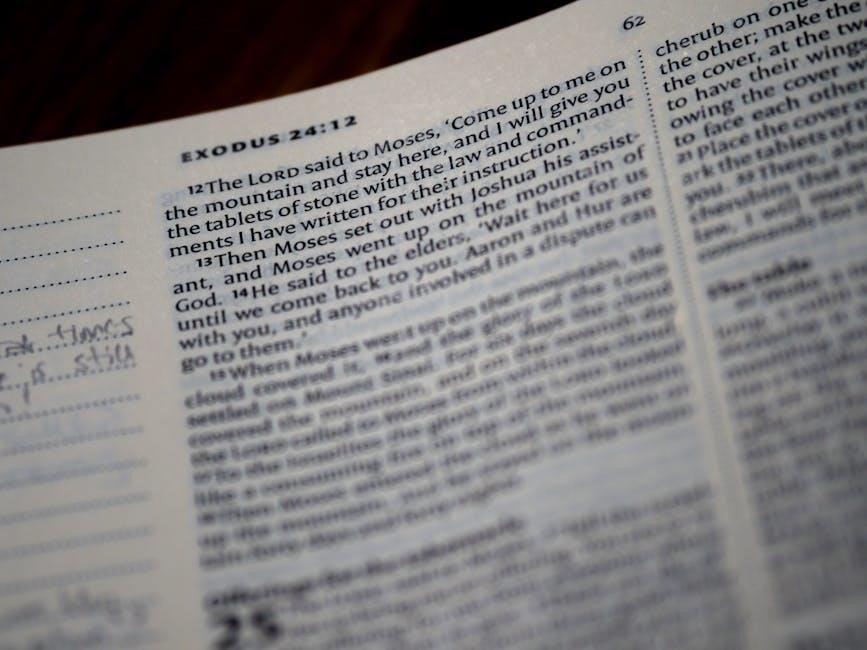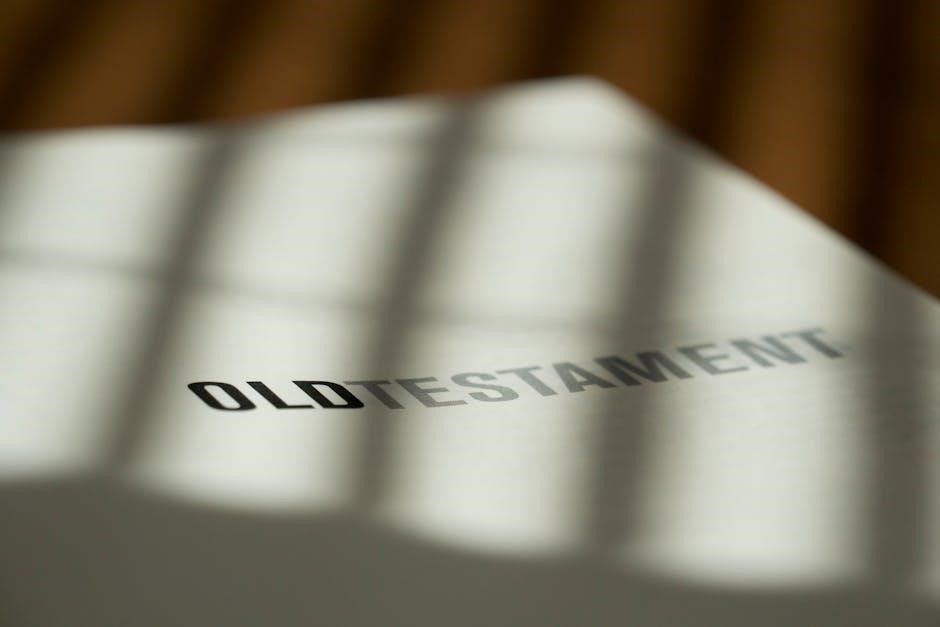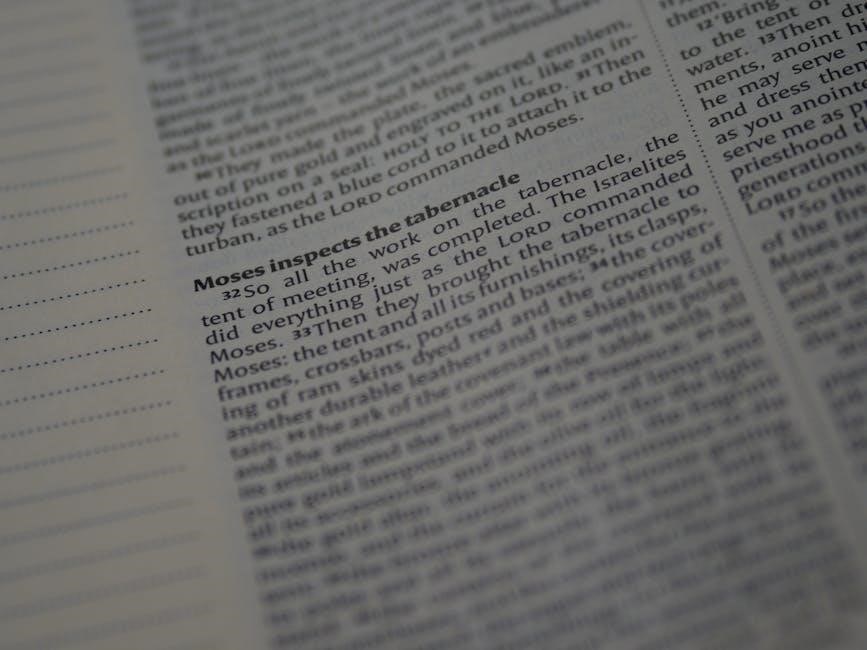1.1 Definition and Overview
The Testament of Moses is an ancient Jewish text‚ part of the Pseudepigrapha‚ presenting itself as Moses’ farewell speech. It combines apocalyptic visions with historical reflections‚ offering insights into early Jewish religious thought.
The Testament of Moses is an ancient Jewish text classified among the Pseudepigrapha‚ presenting itself as the farewell speech of Moses to the Israelites. It blends apocalyptic visions with historical reflections‚ offering insights into Jewish religious thought during the Second Temple period. The text is structured as a prophecy delivered by Moses before his death‚ outlining the future of Israel‚ divine judgment‚ and the ultimate redemption of God’s people. It is distinct from the Apocalypse of Moses‚ though both texts share thematic connections. The Testament of Moses is notable for its detailed historical panorama‚ referencing events such as the destruction of Jerusalem and the reign of Herod‚ while emphasizing God’s covenant faithfulness. Its apocalyptic tone reassures readers of divine sovereignty and the promise of a redeemed future. The text has been preserved in fragmentary Latin manuscripts and is widely studied for its theological and historical significance.
1.2 Historical Context
The Testament of Moses emerges from a period of significant upheaval in Jewish history‚ reflecting themes of divine sovereignty‚ covenant faithfulness‚ and national destiny. Scholars date its composition primarily between the 1st century BCE and the early 1st century CE‚ with some arguing for an earlier core text expanded later. The text references pivotal events such as the destruction of Jerusalem in 587 BCE‚ the Hasmonean rule‚ and the reign of Herod‚ indicating a historical consciousness. It also alludes to the war of Varus in 4 BCE‚ situating it within the turbulent transition from Hasmonean to Roman rule. The apocalyptic tone and prophetic outlook suggest a response to political and religious crises‚ offering reassurance of God’s ultimate redemption. The text’s historical context is further complicated by debates over its redactional layers‚ with some scholars proposing interpolations during the Herodian or post-Herodian periods. This complexity underscores its role as a reflective and prophetic work addressing the Jewish community’s hopes and struggles during a transformative era.

Historical Background
The Testament of Moses is rooted in Jewish tradition‚ reflecting events like the destruction of Jerusalem and Hasmonean rule‚ with scholars dating it to the 1st century CE‚ blending apocalyptic themes with historical reflection.
2.1 Discovery and Manuscripts
The Testament of Moses was rediscovered in 1861 by Antonio Ceriani in the Ambrosian Library‚ Milan. The Latin manuscript‚ incomplete‚ lacks Moses’ assumption but contains prophecies. Its fragmentary nature has led scholars to debate its origins and composition‚ with some suggesting it combines two works: the Testament and the Assumption of Moses. The text is believed to have been originally written in Hebrew‚ with the surviving Latin version possibly edited later. Despite its incomplete state‚ it remains a significant source for understanding Jewish apocalyptic literature and early Christian influences. Digital versions‚ including PDF formats‚ have made this text accessible for modern study and research.
2.2 Date of Composition
Scholars debate the exact date of the Testament of Moses‚ with theories ranging from the early Maccabean period (2nd century BCE) to the 1st century CE. Some argue it was written during Herod’s reign or shortly after‚ citing references to historical events like the war of Varus in 4 BCE. Others suggest it was composed later‚ with predictions extending into the 1st century CE. The text reflects knowledge of events like the destruction of Jerusalem in 587 BCE and the Hasmonean rule‚ indicating it was written after these occurrences. While some scholars propose earlier origins with later interpolations‚ the majority agree it was finalized around the turn of the era. This dating aligns with its apocalyptic themes and its purpose to reassure Jewish communities of God’s covenant faithfulness amid turmoil. The precise date remains uncertain due to the text’s fragmented and edited nature.
2.3 Authorship and Origins
The Testament of Moses is a pseudepigraphic work‚ meaning its authorship is attributed to Moses‚ though it was not written by him. Scholars believe it originated in a Jewish milieu‚ possibly within the Qumran community‚ given its apocalyptic themes and connections to other Qumran texts. The original language is thought to be Hebrew‚ with the surviving text preserved in Latin. Some scholars‚ like Leonhard Rost‚ link it to the Essenes‚ citing similarities with the Damascus Document and the War Scroll. The author likely drew from Deuteronomy 31-34‚ blending prophecy with historical reflection to address Jewish concerns during turbulent times. While the exact author remains unknown‚ the text reflects a sophisticated theological perspective‚ aiming to reassure its audience of God’s covenant faithfulness. Its apocalyptic style and historical allusions suggest a composition influenced by events of the 1st century CE‚ making it a significant yet enigmatic work in early Jewish literature.

Structure and Content
The Testament of Moses presents Moses’ prophecies and farewell address‚ blending historical narrative with apocalyptic visions. It outlines Israel’s future‚ from destruction to redemption‚ offering a panoramic view of Jewish history with an optimistic tone.
3.1 Narrative and Prophecies
The Testament of Moses unfolds as a narrative delivered by Moses to Joshua‚ containing prophecies about Israel’s future; It begins with Moses recounting the Exodus and concludes with visions of Israel’s history‚ including the destruction of Jerusalem and the rise of the Hasmoneans. The text blends apocalyptic imagery with historical reflection‚ creating a vivid tapestry of Jewish destiny. Central to the narrative is the prediction of a messianic figure and a final redemption‚ offering hope amidst adversity. Moses’ prophecies are interwoven with ethical exhortations‚ emphasizing covenant fidelity and divine justice. The text’s apocalyptic tone underscores God’s sovereignty over history‚ reassuring readers of His faithfulness despite impending crises. This prophetic narrative serves as both a warning and a comfort‚ encapsulating the essence of Jewish religious thought during the Second Temple period.
3.2 Key Themes
The Testament of Moses explores themes of divine providence‚ covenant fidelity‚ and eschatological hope. It emphasizes God’s sovereignty over history‚ portraying Him as a faithful ruler who guides Israel through trials. The text underscores the importance of adhering to the commandments‚ warning of consequences for disobedience while promising redemption for the faithful. A central theme is the struggle between good and evil‚ symbolized by the dispute over Moses’ body‚ reflecting broader theological debates. The messianic expectation is another key element‚ offering a vision of future salvation. The text also addresses the tension between present suffering and future triumph‚ providing comfort to a community facing persecution. These themes‚ woven into a prophetic narrative‚ resonate with Jewish apocalyptic literature‚ highlighting the interplay between historical events and divine plan. Together‚ they form a compelling vision of Israel’s destiny‚ rooted in tradition yet oriented toward the future.

The Apocalypse of Moses
The Apocalypse of Moses is a composite work‚ combining the Testament of Moses with the Assumption of Moses. It includes a famous dispute between Michael and the Devil over Moses’ body‚ blending prophecy and eschatology.
4.1 Relationship to the Testament
The Apocalypse of Moses is closely linked to the Testament of Moses‚ as both texts are part of a larger literary tradition. The Apocalypse expands on themes introduced in the Testament‚ particularly Moses’ death and his ascension. While the Testament focuses on Moses’ prophetic address to Israel‚ the Apocalypse delves into the supernatural events surrounding his departure. Scholars suggest that the Apocalypse may have been appended to the Testament‚ creating a composite work that bridges prophecy and eschatology. The two texts share theological motifs‚ such as divine judgment and the fate of Israel‚ but their tones and narrative styles differ. The Apocalypse emphasizes the cosmic significance of Moses’ death‚ while the Testament centers on his earthly legacy. This relationship highlights the evolution of Jewish apocalyptic literature‚ blending historical reflection with visionary prophecy.
4.2 Content and Differences
The Apocalypse of Moses differs significantly from the Testament of Moses in both content and tone. While the Testament focuses on Moses’ farewell address to Israel‚ detailing prophecies and historical reflections‚ the Apocalypse centers on the supernatural events surrounding Moses’ death. It includes the famous dispute between Michael and the Devil over Moses’ body‚ a narrative not found in the Testament. The Apocalypse also explores themes of divine judgment‚ the afterlife‚ and the ultimate triumph of God’s people‚ offering a more apocalyptic vision. In contrast‚ the Testament concludes on an optimistic note‚ emphasizing Israel’s future redemption. The two texts also differ in style‚ with the Apocalypse employing vivid imagery and eschatological language‚ while the Testament remains grounded in historical and prophetic discourse. These distinctions highlight their unique roles within early Jewish literature‚ catering to different theological and narrative purposes.

Relation to Biblical Texts
The Testament of Moses draws from Deuteronomy 31-34‚ echoing Old Testament themes‚ and is referenced in Jude 9‚ linking it to New Testament discussions of Michael and Moses’ body dispute.
5.1 Old Testament Connections
The Testament of Moses is deeply rooted in Old Testament themes‚ particularly drawing from Deuteronomy 31-34‚ where Moses delivers his final address to Israel. It mirrors the biblical account of Moses’ death and succession by Joshua‚ emphasizing covenant obedience and divine judgment. The text extends these themes by incorporating apocalyptic visions‚ resembling Old Testament prophetic literature. Scholars note that the Testament of Moses reflects a continuation of Moses’ role as a mediator of God’s covenant‚ aligning with his portrayal in the Pentateuch. The narrative structure and theological motifs‚ such as the expectation of a messianic figure‚ further connect it to Old Testament traditions. This text serves as a bridge‚ blending biblical history with extrabiblical revelations‚ offering insights into how Jewish traditions interpreted Moses’ legacy in the post-biblical period.
5.2 New Testament References
The Testament of Moses contains elements that resonate with New Testament themes‚ particularly in its apocalyptic imagery and eschatological expectations. A notable connection is the dispute over Moses’ body between Michael and the Devil‚ referenced in Jude 9 of the New Testament. This episode‚ while not explicitly described in the surviving text of the Testament of Moses‚ highlights a shared theological motif. Additionally‚ the text’s prophetic tone and expectation of a messianic figure align with New Testament concepts of divine deliverance. Scholars suggest that early Christian writers may have drawn inspiration from such Jewish texts‚ blending apocalyptic traditions with emerging Christian theology. The Testament of Moses thus serves as a bridge between Jewish and early Christian thought‚ illustrating the rich theological exchange of the time.

Scholarly Perspectives
Scholars debate the Testament of Moses’ date‚ with some attributing it to the 1st century CE due to references to Herod and post-Herodian events‚ while others suggest earlier origins with later additions.

6.1 Date Controversies
The dating of the Testament of Moses remains a subject of significant scholarly debate. Some researchers argue for an early 1st-century CE composition‚ possibly between 7-30 AD‚ based on references to Herod’s reign and post-Herodian events. Others propose a later date‚ even into the 2nd century CE‚ citing the text’s apocalyptic themes and its potential reflection of later historical contexts. The fragmented state of the manuscript complicates precise dating‚ as key sections are mutilated or missing. Scholars like Emil Schürer and Martin McNamara suggest that portions of the text‚ such as chapters 6-7‚ may have been interpolated or updated during the Herodian period. These interpolations could explain the text’s alignment with events like the destruction of Jerusalem in 587 BCE or the rule of the Hasmoneans. The lack of consensus underscores the challenges in pinpointing its exact composition‚ leaving the date of the Testament of Moses an open question in academic circles.
6.2 Authorship Theories
The authorship of the Testament of Moses is a topic of ongoing scholarly discussion. While the text is attributed to Moses‚ it is widely regarded as pseudepigraphical‚ meaning it was written by an unknown Jewish author or authors. Some scholars‚ like Leonhard Rost‚ suggest the text may have originated within the Essene community‚ given its apocalyptic themes and connections to Qumran literature. Others‚ such as John J. Collins and James Charlesworth‚ propose that the work reflects the perspectives of Palestinian Judaism‚ possibly linked to the Qumran milieu. The text’s original language is believed to be Hebrew‚ with later translations into Latin. Some theories suggest multiple authors contributed to the text over time‚ with interpolations added during the Herodian period. Despite these theories‚ the precise identity of the author(s) remains unclear. Philippi even speculates about potential Christian influence‚ though this view is not widely accepted. The text’s anonymity and composite nature continue to fuel debates among researchers.
6.3 Interpretations and Debates
The Testament of Moses has sparked significant interpretative debates among scholars. Its apocalyptic themes and historical predictions‚ particularly regarding the destruction of Jerusalem and the rise of the Hasmoneans‚ have led to varying views on its purpose. Some scholars‚ like John J. Collins‚ interpret the text as an apocalypse‚ emphasizing its eschatological messages and divine reassurances to Israel. Others‚ such as James C. VanderKam‚ argue that it blends apocalyptic and testamentary genres‚ focusing on Moses’ role as a mediator of covenantal truths. A key debate centers on whether the text is a unified work or a composite of earlier materials‚ with some suggesting interpolations were added during the Herodian period. Additionally‚ the optimistic conclusion has been interpreted as a theological message of hope‚ countering the despair of Jewish persecution. These interpretations highlight the text’s complexity and its significance in understanding early Jewish religious thought.

Digital Availability
The Testament of Moses is widely available as a PDF‚ with versions accessible through online libraries and repositories. Google has digitized the text as part of its book preservation efforts.
7.1 PDF Versions
The Testament of Moses is readily available in PDF format through various online platforms. Google Books offers a digitized version of the text as part of its public domain collection. Additionally‚ websites like earlyjewishwritings.com provide free access to the document‚ enabling scholars and readers to explore its apocalyptic visions and historical reflections. The PDF versions typically include the complete text‚ featuring Moses’ prophecies and farewell address to Joshua. These digital editions are invaluable for research‚ as they preserve the original content while making it accessible to a global audience. The availability of the Testament of Moses in PDF format ensures its teachings and insights remain accessible for modern study and interpretation.
7.2 Online Resources and Libraries
The Testament of Moses is widely accessible through online resources and libraries‚ making it easy for scholars and enthusiasts to explore. Platforms like Google Books and earlyjewishwritings.com offer free access to digitized versions of the text‚ ensuring its availability for global audiences. These resources often include introductions‚ translations‚ and scholarly notes‚ enhancing understanding of the document’s historical and religious significance. Additionally‚ many academic libraries provide access to the Testament of Moses through their digital collections‚ featuring both original and interpreted versions. Online archives also host discussions and analyses from experts‚ further enriching the study of this ancient text. These resources are invaluable for those seeking to delve into the apocalyptic visions and teachings attributed to Moses‚ making the Testament of Moses a readily accessible and widely studied work in the digital age.


Cultural and Historical Impact
The Testament of Moses has left a profound mark on Jewish and Christian religious thought‚ influencing early theological discourses and apocalyptic literature. Its themes of divine justice‚ covenant faithfulness‚ and eschatological hope resonated deeply with ancient audiences‚ shaping their understanding of history and destiny. The text’s vivid prophecies and Moses’ role as a mediator between God and humanity elevated its significance in religious traditions. The dispute over Moses’ body‚ referenced in Jude 9‚ highlights its early Christian influence. Over centuries‚ the manuscript’s preservation‚ despite its fragmented state‚ underscores its enduring relevance. Digital availability has further amplified its reach‚ making it accessible to modern scholars and enthusiasts. This text remains a vital resource for exploring the intersection of Jewish and Christian thought‚ offering insights into the cultural and religious dynamics of the ancient world.
